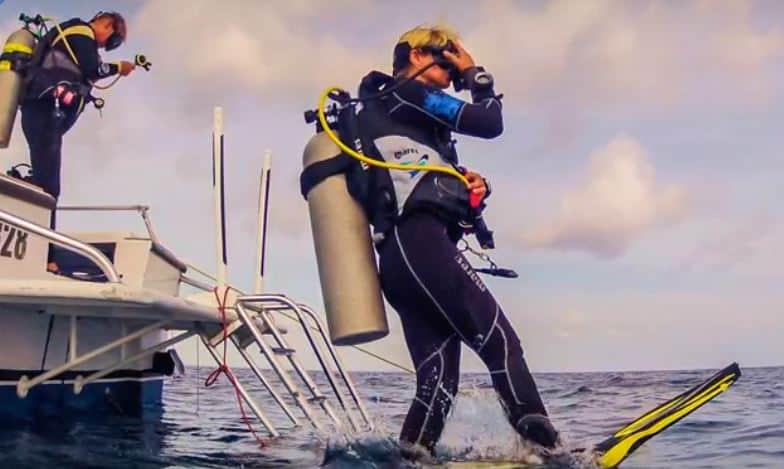

One of the common concerns of scuba diving newbies is how to enter the water safely and efficiently. There are several ways that a diver can enter the water correctly from a boat or a platform. Don’t worry if your choice of entry method differs from another diver you know because some divers may feel more comfortable in some methods than others. The actual entry method may be affected by the type of boat you’re diving from, depth of the dive site, condition of the water, and others.
If you’re a beginner or intermediate diver, here are the four entry methods worth mastering to make each dive a worthwhile adventure.
The giant-stride entry is a popular choice when diving from a flat bottomed boat or a pontoon and entering deep water. Aside from being a popular technique, the giant-stride entry is also easy and convenient. To do this, your boat must have a platform or an open deck, otherwise, it is not advisable to do a giant-stride entry from a high edge.
How to do a giant-stride entry:
The backward roll is often used when diving from a small boat, inflatable boat, or dinghy.
How to do a backward roll:
Entering the water from a seated position is ideal when the water is too shallow for a back roll or giant-stride entry or when the surface is unsteady.
This technique does not create a big splash or too much noise when entering the water, unlike other methods. This can be useful when diving in an area where there could be sharks or other marine creatures that you don’t want to disturb.
How to do a seated entry:
The wading entry method comes in handy when diving from the shore or the beach. This technique is not advisable when water conditions are rough and the surface is muddy.
How to do the wading entry:
This blog article is not intended to replace formal scuba instruction. If you’re diving in Dubai, you can enroll in a diving course at Nemo Diving Center. If you’re a beginner, we’ll teach you all the basic scuba skills including different entry methods. Aside from beginner courses, we also offer advanced and professional diving courses.
Experiences
Find the perfect escape
© 2024 NEMO DIVING CENTER
Scuba diving is an exciting and adventurous water sport that offers a chance to explore the beauty of the underwater world and its amazing marine life. The UAE, particularly Dubai, is one of the most popular destinations for scuba diving, attracting divers from all over the world. With its crystal clear waters and diverse marine life, scuba diving in Dubai offers a unique and unforgettable experience.
The cost of scuba diving in Dubai varies depending on the dive center you choose and the type of dive you opt for. On average, a single dive can cost anywhere from AED 250 to AED 550, with the average price for a single dive being around AED 350. This price usually includes all the necessary equipment, such as the dive tank, regulator, and wetsuit, as well as the services of a professional dive guide. At Nemo Diving Center, We offer a wide range of diving packages to suit every budget and experience level.
Diving in Dubai is an incredible experience, and the UAE is home to many dive sites teeming with amazing marine life including colorful soft and hard corals, sea turtles, stingrays, manta rays, moray eels, cuttlefish, octopus, nudibranchs, seahorses, and a plethora of fish species. It is also noted for its incredible dive wrecks that have become rich artificial reefs. These dive sites offer a unique and exciting diving experience, providing a chance to explore sunken ships and other structures that have become havens for marine life.
Come and explore the unique underwater world of Palm Jumeriah in Dubai and incredible dive sites in Fujairah such as Dibba Rock, Sharm Rock, Martini Rock, Snoopy Island, and more. At Nemo Diving Center, we offer dive trips to these amazing dive sites, allowing divers to discover the incredible marine life that has made the wreck its home. We also offer a wide range of other dive sites to choose from, including shallow coral reefs, deep wrecks, and drift dives, providing something for every level of diver.
In conclusion, scuba diving in Dubai offers an unforgettable experience for all levels of diver. With its clear waters, diverse marine life, and incredible dive sites, Dubai is a must-visit destination for any scuba diver. Whether you’re a beginner or an experienced diver, our team at Nemo Diving Center will ensure that you have an amazing time exploring the beauty of the underwater world.
Click one of our contacts below to chat on WhatsApp
Social Chat is free, download and try it now here!
